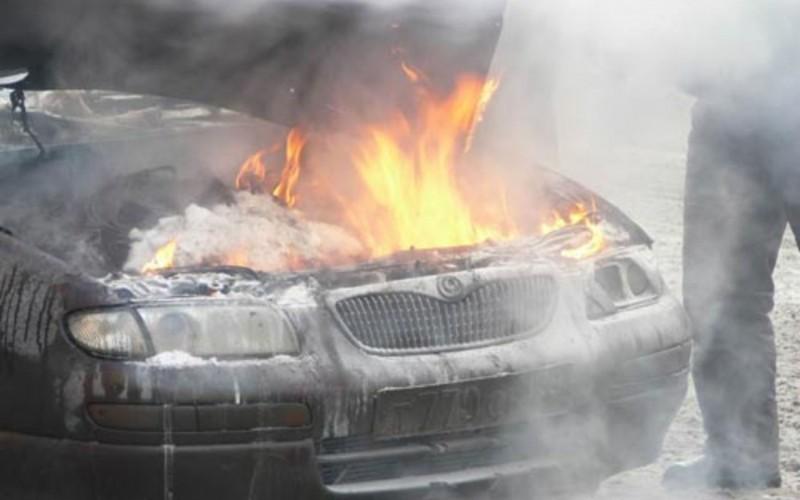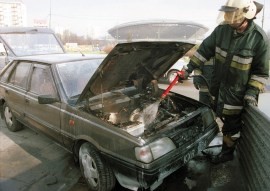
fire under the hood
 Car fires are dangerous. A fire near gas tanks or gas cylinders is not to be taken lightly, but the risk of an explosion is lower than it seems.
Car fires are dangerous. A fire near gas tanks or gas cylinders is not to be taken lightly, but the risk of an explosion is lower than it seems.
Car fires are dangerous. Drivers fear that the car will explode. A fire near gas tanks or gas cylinders is not to be taken lightly, but the risk of an explosion is lower than it seems.

The engine of a Polonaise entering a roundabout in Katowice caught fire.
- Not a single indicator on the dashboard indicated anything strange or unusual. The engine temperature was also normal. I had no idea what could have happened. But from under the hood more and more smoke poured - - says the driver, who was driving from Ruda Sileska to work in the center of Katowice. He pulled quickly to the side of the road and reached for the fire extinguisher. There was already smoke and fire under the hood. “At the moment, there’s not much I can do with the little fire extinguisher that everyone has in their car. Fortunately, four other drivers who took their fire extinguishers and helped me immediately stopped ... - says Mr. Roman, the owner of the burned-out car.
Unfortunately, not always and not everyone reacts this way. We often indifferently pass by burning cars.
According to Mr. Roman, the rescue operation went very quickly. The drivers who helped him knew what they were doing and how to prevent the fire from spreading. First, without lifting the hood, they pushed the contents of their fire extinguishers through the holes in the bumper (in front of the radiator), then they tried the same with all the available slots and under the car. Raising the mask would allow more oxygen to enter, and the fire would explode with even more force. Only after some time, through a rag, they slightly opened the hood and continued to extinguish. When firefighters arrived a short time later, all they had to do was put out the engine compartment and check for signs of fire anywhere.
- This fire was all the more dangerous because there was a gas installation in my car and I was afraid that it might explode - Mr Roman says.
He'd rather burn than explode
According to firefighters, the cars are on fire, not exploding.
– Gasoline or liquefied gas in cylinders do not burn. Their fumes are on fire. For ignition, there must be an appropriate mixture of fuel vapor and air. If someone saw burning gasoline in a bucket, then they probably noticed that it burns only on the surface (i.e., where it evaporates), and not in its entirety - says Brigadier General Jarosław Wojtasik, spokesman for the voivodship headquarters of the State Fire Service in Katowice. He himself was deeply interested in the question of the danger of installing gas installations in a car, because he has such equipment in his car.
Gas and gasoline closed in tanks or fuel lines are relatively safe. Since there is always a risk of leakage and evaporation will begin to come out.
“There is always the risk of an explosion. Even domestic gas bottles that are designed to be safely placed next to stoves will explode. sources of open fire. If the tanks are sealed, it all depends on how long they are heated by the flame. During building fires, cylinders often explode even after being left on fire for an hour - says Yaroslav Wojtasik.
Gas installations in cars have several fuses, besides, gas is heavier than air, so if the installation is not airtight, it will fall under a burning car, under a flame, which reduces the risk of an explosion.
Take care of the electrical installation
Tanks and fuel tanks are subject to standards that determine, among other things, their strength, resistance to temperature and high pressure that occurs when the temperature rises around the tank. Typically, the causes of car fires on the road are short circuits in the electrical system. The risk increases, for example, if oil enters the engine compartment. The key to fire prevention is taking care of the condition of the engine, especially the electrical system.
It happens that poorly fixed and fixed cables rub against other elements of engine units or body structures. The insulation wears out, which leads to a short circuit and then to a fire. Short circuits can also be caused by improper repairs or upgrades. It is likely that a short circuit was the cause of yesterday's polonaise at the Katowice roundabout.
The second cause of fires are fuel leaks from plants damaged during the accident. Here the risk of explosion is greater because the pipes are damaged and the fuel leaks out. The fire reaches damaged fuel tanks after traces of a leak. However, even in this case, the outbreak usually does not occur immediately.
– Instant car explosions in movies are pyrotechnic effects, not reality – Yaroslav Wojtasik and Miroslav Lagodzinsky, a car appraiser, agree.
This does not mean that car fires are to be taken lightly.
Check the condition of the fire extinguisher!
Each fire extinguisher has a specific date by which its performance must be checked. If we do not follow this, if necessary, it may turn out that the fire extinguisher will not work and we can only stand by and watch our car burn. On the other hand, driving with an expired fire extinguisher can result in a roadside inspection fine.
Photo Author
To the top of the article

